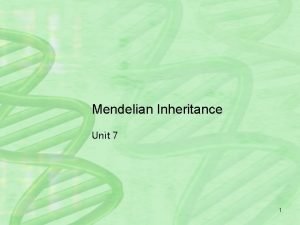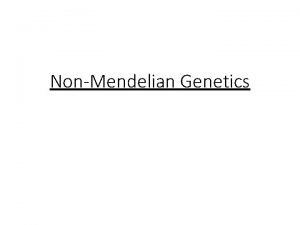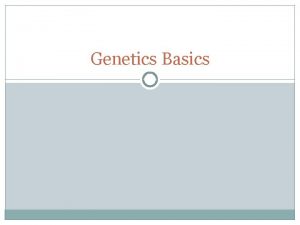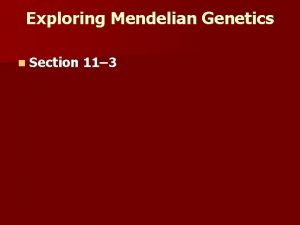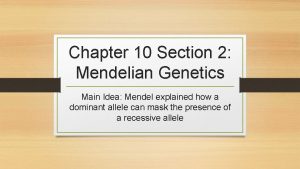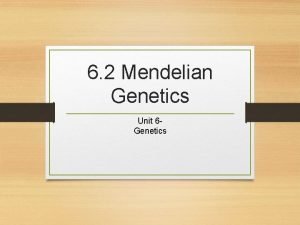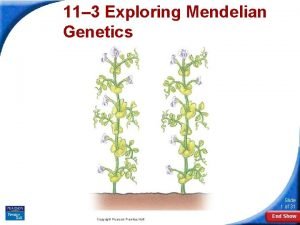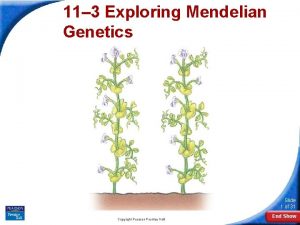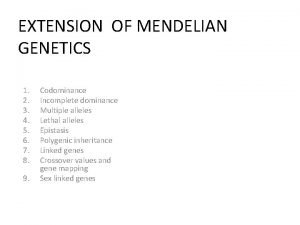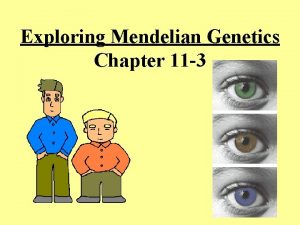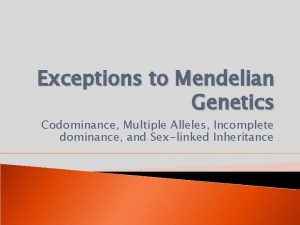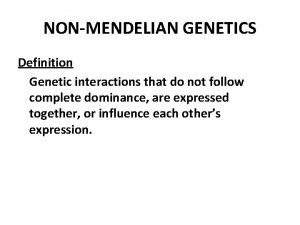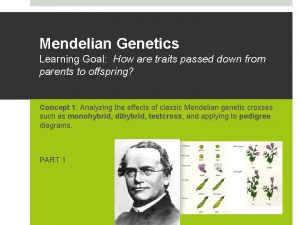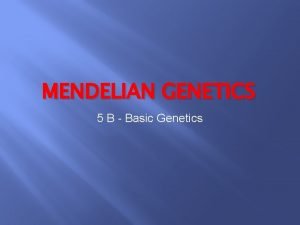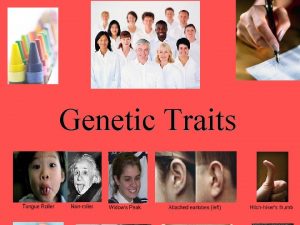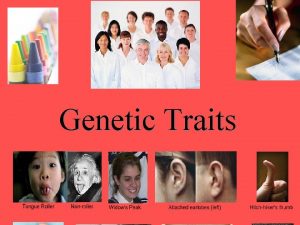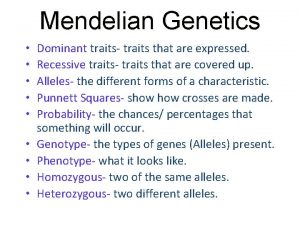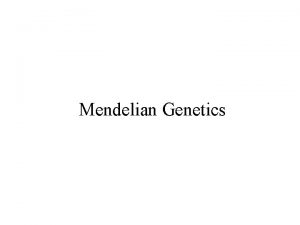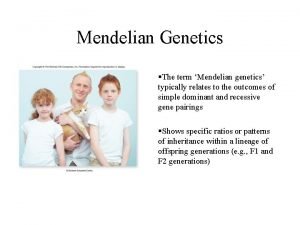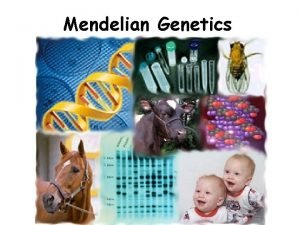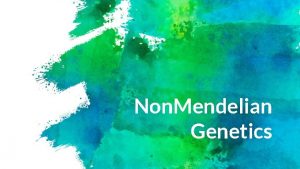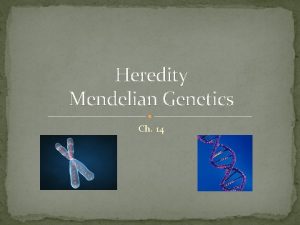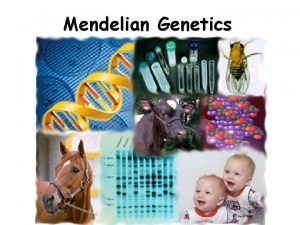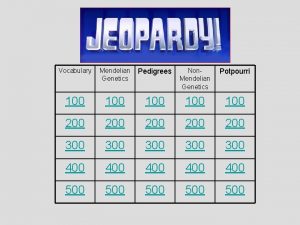Mendelian Genetics Learning Goal How are traits passed
















- Slides: 16

Mendelian Genetics Learning Goal: How are traits passed down from parents to offspring? Concept 1: Analyzing the effects of classic Mendelian genetic crosses such as monohybrid, dihybrid, testcross, and applying to pedigree diagrams. PART 2

Try This! An organism with the genotype Aa. Bb is crossed with an organism that has the genotype AABb. What are all the possible gametes of each individual parent? What is the probability that any of the offspring has the AABB genotype? If A and B exhibit complete dominance, what is the probability of the offspring exhibiting both the A and B phenotypes?

Try This! An organism with the genotype Aa. Bb is crossed with an organism that has the genotype AABb. What are all the possible gametes of each individual parent? Aa. Bb x AABb A A B AB AB Ab Ab A AA AA B BB a. B a Aa Aa b Bb ab b Bb bb What is the probability that any of the offspring has the AABB genotype? AABB – 2 punnet squares! AA: ½ BB: ¼ ½ x ¼ = 1/8 If A and B exhibit complete dominance, what is the probability of the offspring exhibiting both the A and B phenotypes? What genotypes give dominance for A and B? A_B_ A_: 1 B_: ¾ 1 x ¾ = 3/4

Concept 1: Analyzing the effects of classic Mendelian genetic crosses such as monohybrid, dihybrid, testcross, and applying to pedigree diagrams. Terms associated with genetics problems: P, F 1, F 2, dominant, recessive, homozygous, heterozygous, phenotypic, and genotypic How to derive the proper gametes, genotypes, and phenotypes, when working a genetics problem (monohybrid, dihybrid, testcross) The difference between an allele and a gene How to read a pedigree (monohybrid, dihybrid, testcross)


Make Math Work for YOU! Rule of Multiplication: Independent events happening at the same time “this and that together” Example: three coins are flipped. The probability that all three coins show tails is ½ x ½ = 1/8

Make Math Work for YOU! Rule of Addition Mutually exclusive events “this or that” “different ways of getting the same thing” Example: three coins are flipped. What is the probability of getting one tail and two heads? - tail, head 1/8 (½ x ½ rule of multiplication) - head, tail 1/8 - head, tail, head 1/8 The probability that two coins are heads and one is tail is: 1/8 + 1/8 = 3/8

Tips for working through genetics problems: THERE IS NO MAGICAL FORMULA!!!! What do you HAVE? What do you WANT? Plan a way to get there using a combination of: punnet squares probabilities logic

Try This! In peas, yellow seed colour is dominant over green seed colour, and round seed shape is dominant over wrinkled seed shape. A round-yellow seeded plant was crossed with a greenwrinkled seeded plant producing 20 plants: 11 of these plants has yellow-round seeds, and 9 of these plants had green-round seeds. What was the probable genotypes of the parent plants?

Tips for working through genetics problems: Write down the allele symbols using the same letter for a gene: upper case for dominant (ex: Yellow – Y) lower case for recessive (ex: green – y). Write down the phenotypes for each individual.

Tips for working through genetics problems: Write down possible genotypes for each individual. If the phenotype is recessive, genotype must be homozygous recessive (green = yy) If the phenotype is dominant, genotype is either homozygous dominant or heterozygous. (yellow = YY or Yy, can write Y_) If the phenotype is “true-breeding, ” the genotype is homozygous for that trait.

Tips for working through genetics problems: Write down what you are looking for in the question. If you need to find genotype/phenotypes of offspring (or “grandchildren”), complete the cross (Yy x yy) and use the probability rules or the Punnet square. If you need to find genotypes/phenotypes of parents or (or “grandparents”), deduce by working backwards and reasoning. (Note: numbers of offspring may be actual rather than predicted by ratios… 1: 1 ratio may be 13 individuals: 15 individuals)

Shortcuts! 3: 1 ratio indicates a monohybrid cross (Aa x Aa) 1: 1 ratio indicates a cross of a heterozygote with a homozygous recessive (Aa x aa) All offspring identical to parents suggests a cross of parents that are homozygous for the same trait, or homozygous dominant with heterozygous (AA x AA or aa x aa or AA x Aa) 9: 3: 3: 1 ratio indicates a dihybrid cross (Aa. Bb x Aa. Bb) 1: 1: 1: 1 ratio indicates a cross of a dihybrid with a double homozygous recessive (Aa. Bb x aabb)

We just need to practice… Try… On Worksheets: Multiple Choice: 1, 2, 3, 5, 7, 8, 10, 13 Genetics Problems: 1, 2, 6, 12, 13 s t i a r re t a w o H : l m a o r o f G n g w ? n o i g d n n r i d r Lea passe o offsp t s t n e r a p

Pedigrees…

 Insidan region jh
Insidan region jh Family resemblance test
Family resemblance test Is baldness a sex linked trait
Is baldness a sex linked trait Section 11-3 exploring mendelian genetics answer key
Section 11-3 exploring mendelian genetics answer key Heterozygous for type a blood
Heterozygous for type a blood Chapter 7 extending mendelian genetics
Chapter 7 extending mendelian genetics Section 11-3 exploring mendelian genetics
Section 11-3 exploring mendelian genetics Chapter 10 section 2: mendelian genetics
Chapter 10 section 2: mendelian genetics Mendel was a
Mendel was a 11.3 exploring mendelian genetics
11.3 exploring mendelian genetics 11-3 exploring mendelian genetics
11-3 exploring mendelian genetics Extending mendelian genetics answer key
Extending mendelian genetics answer key Pprr x pprr punnett square
Pprr x pprr punnett square Section 11-3 exploring mendelian genetics answer key
Section 11-3 exploring mendelian genetics answer key Hors xnxn
Hors xnxn Chapter 7 extending mendelian genetics vocabulary practice
Chapter 7 extending mendelian genetics vocabulary practice Penetrance
Penetrance

